
Agapanthus africanus, or the African lily, is a flowering plant from the genus Agapanthus found only on rocky sandstone slopes of the winter rainfall fynbos from the Cape Peninsula to Swellendam. It is also known as the lily-of-the-Nile in spite of only occurring in South Africa.
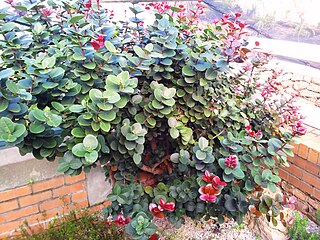
Maurocenia frangula is a small, rounded tree of about 4 metres, that is endemic to the Western Cape, South Africa.

Cape Winelands Shale Fynbos is a vegetation type that naturally occurs in the Cape Winelands of the Western Cape, South Africa.

The Harold Porter National Botanical Garden covers almost 200 ha between mountain and sea, in the heart of the Cape Fynbos region within the Kogelberg Biosphere Reserve to the east of Cape Town, South Africa, specifically near Betty's Bay along Clarence Drive (R44). With about 1,600 plant species, the area contains a floral diversity per unit area that is greater than anywhere else in the world. The Garden consists of 10 hectares of cultivated gardens and 190.5 hectares of pristine natural fynbos. In addition, 60 species of birds can be found there, as well as porcupines, genets, skunks, hyraxes, baboons, and snakes. Foot trails reach cliffs, ravines, heaths, forests, streams, and mountain pools.

Tokai Park, previously known as "Tokai Forest", is a small wing, about 600 ha, of the greater Table Mountain National Park in Cape Town, South Africa. Tokai Park is made up of two sections: upper and lower Tokai Park. Lower Tokai Park is flat, and characterized by the threatened Cape Flats Sand Fynbos. Upper Tokai Park is on the slopes of Constantiaberg Mountain, and consists of conservation area as well as the Tokai Arboretum. Upper Tokai Park is characterized by Peninsula Granite Fynbos, Peninsula Sandstone Fynbos and Afromontane Forest and noted for its diversity.
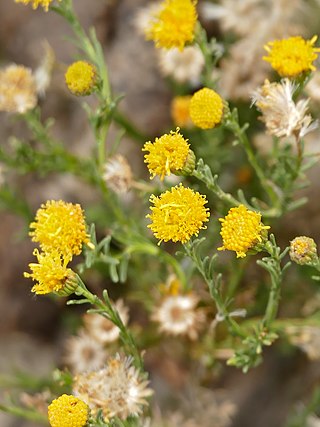
The African sheepbush is a plant native to South Africa and Namibia. It ranges throughout the Succulent Karoo, Nama Karoo, renosterveld, and fynbos, and it is listed under the SANBI Red List as "safe" (LC).
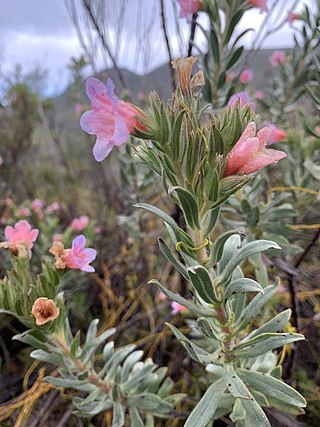
Lobostemon curvifolius, the largeflower healthbush, is a species of the forget-me-not family from South Africa.
Serruria candicans, the shiny spiderhead, is a flower-bearing shrub that belongs to the genus Serruria and forms part of the fynbos. The plant is native to the Western Cape, where it occurs from Elandskloof to the Slanghoek Mountains and Paardeberg at Malmesbury. The shrub is erect and grows only 80 cm tall and bears flowers from July to December.

Serruria glomerata, the cluster spiderhead, is a flower-bearing shrub that belongs to the genus Serruria and forms part of the fynbos. The plant is native to the Western Cape, it occurs on the Cape Flats and Cape Peninsula. The shrub is erect and grows only 40 cm tall and bears flowers from August to October.
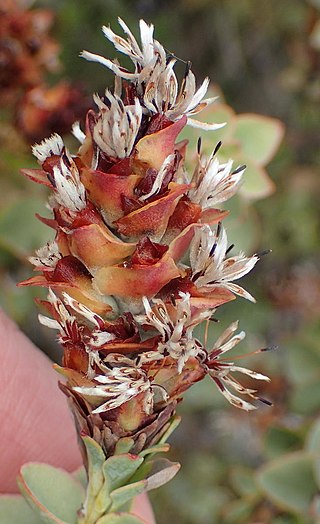
Paranomus roodebergensis, also known as the honey-scented sceptre, is a flower-bearing shrub that belongs to the genus Paranomus and forms part of the fynbos. The plant is native to the Western Cape, South Africa.
Paranomus capitatus, the fine-leaf sceptre, is a flower-bearing shrub that belongs to the genus Paranomus and forms part of the fynbos. The plant is native to the Western Cape where it occurs in the Du Toits Mountains south of Du Toitskloof Pass to the northern slopes of the Riviersonderend Mountains.

Paranomus tomentosus, the hairy-leaf tree sceptre, is a flower-bearing shrub that belongs to the genus Paranomus and forms part of the fynbos. The plant is native to the Western Cape, South Africa.
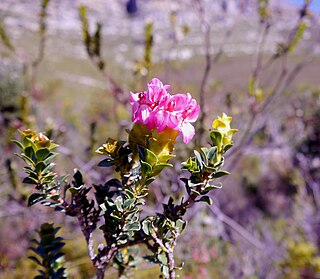
Penaea sarcocolla is a species of shrub in the genus Penaea. It is endemic to the Western Cape, along the coast up to Cape Agulhas and extending inland to Franschhoek, Hottentots Holland Mountains, Villiersdorp and Genadendal. It is also known as the Cape fellwort.
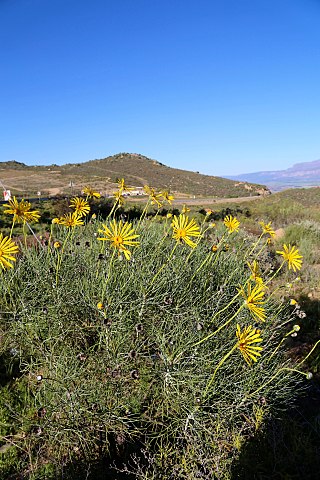
Euryops speciosissimus is a species of flowering shrub in the genus Euryops. It is endemic to the fynbos region of South Africa. It is also known as the Clanwilliam daisy and giant resinbush; in Afrikaans it is called harpuisbos, meaning resin bush.
Oscularia lunata is a species of succulent flowering plant in the genus Oscularia. It is endemic to the Fynbos region in the Western Cape.

Ixia scillaris is a perennial cormous flowering plant in the genus Ixia. It is endemic to a small portion of the Fynbos in the Western Cape.
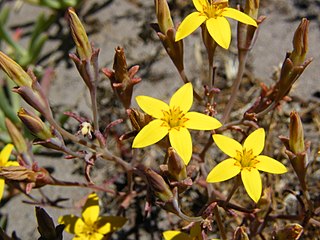
Crassula dichotoma is a species of succulent plant in the genus Crassula. It is endemic to the Fynbos region from Namaqualand to Agulhas.

Willdenowia incurvata is a species of flowering plant in the genus Willdenowia endemic to the Fynbos region of the Northern Cape and Western Cape. It is also known as the sonqua sunreed; or sonkwasriet in Afrikaans.

Stachys rugosa is a species of perennial herb in the genus Stachys.

Cyphia bulbosa, also known by its common name Bulb Baroe, is a species of flowering plant from the genus Cyphia.


















